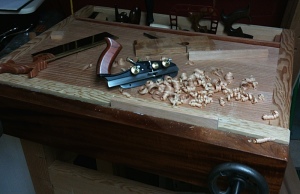Joinery Bench for Small Work Pieces
It is more than 8 months since I completed my Joinery bench. I have cut a lot of joinery from dovetails to dados, tenons, and miters. I have been practicing my carving a lot lately and that has all happened on this bench too. Basically as any small shop woodworker knows, if you have a horizontal surface it will see some action. The big front vise holds so well that I find myself using the joinery bench for all kinds of things especially fine details where placing the work right up close is helpful. I have even started using my rabbet and plow planes on this higher bench top.

Grooved stile in the vise, rabbeted rail behind, saw hook on the left for trimming pieces to length. Everything you need in one place.
The Moxon vise design that Benchcrafted has come up with where the chop floats on the screws is very versatile. The elongated holes allow for a small amount of racking which can be really useful when clamping odd shaped parts but also narrow pieces. I was making a small glass door where the rails and stiles have a rabbet on the inside face to hold the glass. The rail was only 1″ wide and 1/2″ thick. By clamping the rail on edge with only 1/4″ of the width in the jaws, the chop pivots like a leg vise providing solid contact and immense clamping power. I had gauged a line marking the outer edges of the rabbet and was able to drop the boxed corner of my rabbet plane right into the gauge line to start my rabbet. I do this technique any time I stick mouldings but being able to set the work piece up at chest height made it so much easier to see my cut and maintain a square joint.
This was so comfortable, that I proceeded to plow the grooves for a panel door, then the tongue and groove joint for the back panels of the cabinet. Certainly you lose some leverage working up that higher, but for small pieces like these, taking 3/16″ wide cuts, the force to move the planes is minimal.
The more I think about it, I realize that when I cut joints like these on my Roubo workbench, I spend a lot of time bent at the waist checking my layout lines and how the cut is progressing. It doesn’t seem like much but the time to stop, bend, and check my proximity to the lines really added to the time to cut the joint. Now I’m starting to think about building a sticking board up this high…it is worth experimenting to determine if the loss of leg power during the cut will be detrimental in the long run (literally).


